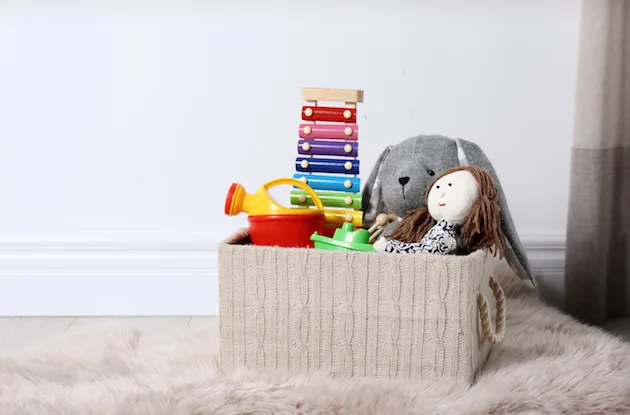Now that winter is (seemingly) on it’s way out, there are a handful of tasks we commonly associate with spring—namely spring cleaning. Though it seems like you hit every nook and cranny in your home during your mega cleaning session, there are quite a few spots you’re likely to overlook. Here are areas to add to your cleaning list, plus a few spring cleaning tips and tricks.
Cleaning. To a lot of us, that’s as bad as a four-letter word. I was a housekeeper at an inn in high school and got the satisfaction of cleaning a space to shine, but—to this day—I have never been a fan of the actual process.
Even some cleaning experts feel the same way: “I really hate cleaning,” says Melissa Maker, a Toronto, Ontario-based cleaning expert, host of the Clean My Space YouTube channel, and author of Clean My Space: The Secret to Cleaning Better, Faster—and Loving Your Home Every Day. “But I love the benefits of living in a clean space.”
Heck, with kids, keeping up with the laundry is almost more than we can handle sometimes. So, if you’re like us—not fans of cleaning, but love having a clean space—you know you have to take out the broom and duster regularly to ensure your home is presentable for play dates and dinner guests without a last-minute, frenzied cleaning session. But did you know you’re likely missing some spots that should be cleaned more often than not?
We got the inside scoop from cleaning experts and enthusiasts on the areas we need to pay a little more attention to when we have the cleaning products out.
Remember: These aren’t commandments—we certainly aren’t likely to keep up with most of this as often as we should—just recommendations for a cleaner, healthier home.
Spots Commonly Missed in the Bathroom
The area around the toilet: “People often clean in the toilet, but they don’t clean the base or the area behind the toilet,” Maker says. “And over time, that can get really gross, especially if you have individuals in the home who stand up to pee instead of sit down to pee.” So whenever you clean the inside of your toilet, spray a disinfectant or all-purpose cleaner around the base and wipe it clean.
Toilet handle: Speaking of missed spots on the toilet, do you regularly, consciously sanitize the flush handle on the toilet? Didn’t think so. Spray it with your preferred cleaner and wipe it down—but please do this before wiping the floor around the toilet, or else use a fresh cleaning cloth.
Medicine cabinet: Because it’s a high-traffic area in the house we don’t typically think of cleaning, it can get quite messy, says Christine Dimmick, author of Detox Your Home: Removing Toxins and Improving Your Life, which is set to be released in early April, and founder of The Good Home Company, a Manhattan-based home care and laundry product line that is paraben-, sulfate-, and phthalate-free. We access our medicine cabinets at least twice a day (when we’re getting ready for work and school in the morning and when we’re getting ready for bed at night), so a lot of water gets in there—and water is the first thing to grow bacteria. Dimmick suggests attacking the medicine cabinet once a month—and her all-purpose cleaners of choice are a mixture of white vinegar and water, or castile soap. And while you’re at it, check the expiration dates on your medicine and beauty products and dispose of them correctly.
Ceiling vent: “If you don’t clean that, it becomes very noisy when it’s on, and it doesn’t remove moisture effectively,” Maker says. The easiest way to clean it, she adds, is to give it a quick vacuum with the brush attachment.
Bath towels, bathmats, and bathrobes: While you won’t necessarily have to do two towel loads in the wash each week—let’s face it, our linen closets are overstuffed with towels and washcloths—your bath towel should be replaced halfway through the week, according to Mary Gagliardi, aka Dr. Laundry for Clorox, whose background is in textile science and research and development at Clorox. And every time you wash a load of towels, go ahead and throw in the bathrobes and bathmats because, as Gagliardi says, they’re used similarly and as often as bath towels. While you’re at it, just find all the towels currently in use in the house and add them to the wash, too—we’re looking at you, kitchen towels.
Gagliardi suggests washing these in bleach to properly disinfect them, after testing the fabrics to make sure they’re bleach-fast. To test, mix 2 teaspoons of bleach with ¼ cup of water, put a drop of the solution on a hidden part of the fabric, let it sit for a minute, and rinse it and blot dry with towel. If the color didn’t change, you can use regular bleach on the item; otherwise go for color-safe bleach.
Toothbrush holder: This is a small thing that is usually overlooked and it has a lot of germs around it, says Jim Ireland, founder of White Glove Elite, a cleaning service in New York City. And it’s one I can attest to after a particularly bad college roommate experience. Let’s just say I always kept my toothbrush separate. So do everyone—and your mouth—a favor and clean the toothbrush holder before it even starts to look grimy.
Shower curtains / vinyl liners: Cloth shower curtains should be washed once a year to freshen them up because things can splash on them. Meanwhile vinyl shower curtains or shower curtain liners should be washed once or twice a year in the washing machine with ½ cup of bleach to keep mold and mildew under control, Gagliardi says. And go ahead and pull the curtain closed after your shower so the liner fully air-dries. This small step also keeps your bathroom looking neat.
Spots Commonly Missed in Bedrooms
Bed sheets: You’re tossing and turning, sweating, and shedding hair and skin cells in your sleep. So regardless of whether you shower at night, sheets should be changed weekly. And in terms of washing them, Gagliardi says she believes they should be bleached—but perform a bleach-ability test on them first! If they fail the bleach-ability test, then wash them in the hottest water possible to properly clean and sanitize them. While you’re at it, gather the throw blankets from the living room and wash those, too.
Mattresses: Maintaining your mattress is really important; after all we spend approximately one-third of our lives sleeping! The best way to clean your mattress, Maker says, is to strip the sheets off it, sprinkle baking soda on it, let the baking soda sit for 30 minutes, and then vacuum it off. This will neutralize any odors. Once the mattress is vacuumed, place a waterproof mattress protector on it and your sheets as normal. Maker also says rotating your mattress two to four times a year is key, so why not clean it at the same time?
Under the bed: It’s a big one, according to Dimmick. A lot of dust can quickly accumulate there, “and by cleaning that, you can solve a lot of your allergy issues, or not sleeping well at night,” she says.
Closets: At least twice a year—but ideally after each season—go through your closets and get rid of any seasonal pieces you didn’t wear that season, suggests Tova Weinstock, aka Tidy Tova, a professional organizer and cleaning enthusiast based in New York City. For example, now that spring is upon us, go through your winter sweaters and donate the ones you weren’t compelled to wear. “Even with people I work with, if they’re debating whether to get rid of a springy shirt, I’ll say, ‘why don’t you keep it and if you don’t wear it this season, then let go of it,’” Weinstock says. Once you’ve gone through everything and the closet is empty, sweep and dust in there and then put everything back in an organized fashion—and the same goes for the drawers in your dresser.
Stuffed animals: These get a lot of love from young children, so they regularly need a freshening up. These can be vacuumed or go in the washing machine (if it’s okay for the lovie) as often as you can get them away from your kids—once a year at the very least.
Spots Commonly Missed in Common Areas
Ceiling fans: The tops of the fan blades can get particularly dusty—out of sight, out of mind. When I moved into my first apartment in New York City, my dad, who sees all those out-of-sight places because he’s 6-foot-4, wiped down the fan blades in my room—and you wouldn’t believe the amount of caked-on dust that came off. I only wish I had known Ireland’s trick: Every few months, dampen a pillowcase, put it over each blade so the fan blade is encased, and slide the pillowcase off so the dust stays inside the pillowcase.
Pet food bowls: If you feed your dog or cat wet food, chances are you regularly wash their bowls to clean off dried-on food. But what about dry food bowls? “A lot of times people have dogs where the food never gets eaten all the way or the cat food is always in there, so it’s nice if once a week you can wash them with soapy water, rinse them, and sanitize them,” Gagliardi advises.
Houseplants: We don’t typically think of plants getting dusty, but they do. “We tend to overlook them until we notice them, and we tend to brush the dust off with our hands, but the oil from our hands is not friendly to plants,” Ireland says. So use a water-dampened cloth when you do your regular dusting, or regularly spray your plants.
Points of contact: We’re talking all over the house here. Bathroom and kitchen cabinet handles, doorknobs, light switches, remote controls, tablets, phones, anything you and your family touch on a daily basis. These points of contact are how germs are transferred from person to person, so these are areas to be particularly mindful about cleaning, Maker says. “You can take a disinfectant and spray those points of contact as long as they don’t have electricity associated with them, you can let that product sit for a minute or two, and then wipe it,” she says. If the point of contact does have an electric component, Maker suggests spraying a cloth with a cleaner or rubbing alcohol and wiping it down.
Litter boxes: While we regularly clean out the litter boxes and refresh the litter, how often do we actually wash the litter box? Probably not often enough. “We have a recommendation for deodorizing litter boxes, where you remove the cat litter and clean the litter box with soapy water, let it soak with a half cup of bleach per gallon of water for five minutes, and rinse it and let it air dry,” Gagliardi suggests. “Put the cat litter back in and that will keep litter boxes smelling much, much better.”
Baseboards, crown molding, and heat registers / return vents: Dust builds up on these. Weinstock, Maker, and Gagliardi all suggest vacuuming them a few times a year with the brush attachment—or stay on top of it by cleaning them every time you vacuum the carpets.
RELATED: What are the best ways to clean my carpets?
Spots Commonly Missed in the Kitchen
Overhead exhaust: The purpose of the overhead exhaust is to suck the greasy vapor out of your kitchen, according to Maker. “On its way up, the vapor leaves behind a significant amount of grease, and as it builds up, it becomes sticky, it becomes rancid, and you really do need to give it a good clean,” she says. Maker recommends you fill up a bucket with hot water and a scoop of oxygen bleach powder, soak it for about 10 minutes, dry it, and put it back up. You may need to give it a bit of a scrub, she cautions.
Potholders: “People never wash those, and they don’t necessarily hold up well to washing,” Gagliardi says. “But if they’re so dirty that you shouldn’t be using them anyway and you wash them and they don’t necessarily have good dimensional stability, then it was time to replace them.” Just be careful when laundering potholders, as they tend to bleed color. Soak them in water first to see how much color runs off; that way you won’t have dye transfer onto other items, Gagliardi advises.
Under the sink: This area tends to become a hotspot for junk, cleaning products, plastic shopping bags, and sometimes bits of trash that miss the garbage can (that is, if you keep the garbage can under the sink). So every now and then, dive in and take everything out, give it a good wipe, and, as Maker recommends, “put in a shelf liner because it can become very wet under there and you can ruin the base of the cabinet.” Then put back only the items you need. Now that we think about it, tackle the cabinet under the sink in the bathroom, too.
Garbage cans and recycling bins: We all regularly take out the garbage and recycling—at the very least when it’s trash day—but cleaning the receptacles themselves is often left undone. Gagliardi suggests disinfecting these once a month, especially if drink cans aren’t rinsed out before going in there. To keep them disinfected and deodorized, she suggests washing them with soapy water, then letting them soak in a solution of ½ cup of bleach per ¾ gallon of water for 5 minutes, rinsing it, and letting it air dry. Alternatively, Ireland suggests using a trash can as a bucket when mopping the floors, which will clean it too.
Inside the microwave: When food is nuked in the microwave, it can splatter, “and most people will leave it for a week, but would you leave food stains or dried up food on your counter for a week? Probably not,” Dimmick says. She suggests cleaning the microwave daily with a mixture of vinegar and water. Meanwhile Weinstock suggests heating up water in the microwave to create a steam, which will loosen up caked-on food, making it easier to wipe off.
Sponges: These can get smelly fast. Rather than throwing them out frequently, every time you run your dishwasher, Gagliardi suggests tossing them in, too. And for a deeper clean, she says you can soak them in a solution of ½ cup of bleach per gallon of water for 5 minutes, rinse them, and let them air dry. For a cleaning double-whammy, get your sponge wet and microwave it on high for 2 minutes, then carefully remove it. This deodorizes and disinfects your sponge, Ireland says, and the steam makes it easier to clean the microwave.
The warming drawer in the oven: People tend to use this little drawer under the oven as storage for baking sheets and think nothing of it since it’s not being used for food. But if you remove everything, “you’ll see it’s just full of crumbs, so every now and then its important to take everything out,” Maker says. “You can use the brush attachment on the vacuum to clean it out, and once you vacuum out the crumbs, spray it and wipe it out, and replace only the items you need.”
Coffee pot and coffee grinder: Ireland suggests these be cleaned once a month. Run the coffee maker with a solution that is 1 part vinegar and 4 parts water. Then, for insulated coffee urns that are difficult to clean, he suggests dropping a denture-cleaning tab in with some hot water and letting that sit overnight, while regular pots can be hand washed with dish soap. And put a handful of uncooked rice in the grinder and grind it. This will clean the blades without needing to get it wet.
Refrigerator: “You can still grow bacteria in there even though it’s cold,” Dimmick says. So she cleans out her fridge once a week. “It’s also a great time to do a deep dive and look at the expiration dates on condiments,” she adds. And make sure to get under the crisper drawers. “We spend a lot of time trying to keep odors out of the refrigerator, but a lot of times there’s stuff under the crisper drawers,” Ireland adds.
With all of this in mind, Weinstock suggests creating a cleaning routine or schedule that is doable for you. “Try to get in the habit of doing certain tasks every day: sweeping, doing the dishes, wiping the counters,” she says. “And then set aside the time to actually clean, otherwise it gets so overwhelming.”
RELATED:
Getting Creative with Chores Will Get Kids Hooked




















